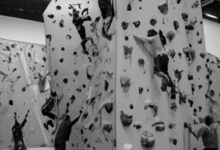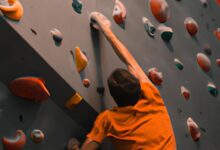A Climbing Prop Would Have Normalized Secured Anchoring Points
Embark on a captivating journey into the world of climbing props, where innovation meets adrenaline. At Goldsport, we believe that every climber deserves the best equipment to elevate their performance and safety. In this comprehensive guide, we’ll delve into the essential features, types, and benefits of climbing props, providing you with the knowledge to make informed decisions and enhance your climbing experience. Whether you’re a seasoned climber or just starting out, discover how a climbing prop would have transformed your climbing adventures.
I. A Climbing Prop Would Have: Understanding the Different Types of Climbing Gear
Venturing into the realm of rock climbing unveils a fascinating world of specialized gear, each piece meticulously designed to enhance safety, performance, and overall climbing experience. These indispensable tools and accessories serve as reliable companions, facilitating climbers’ graceful ascent up sheer rock faces and rugged terrains. Let’s delve into the intricacies of this essential climbing equipment, unraveling their distinct features and functions.
Harnesses: The Lifeline of the Climber“Always remember, a harness is your lifeline, the ultimate guardian of your safety.” – Experienced Climber
- Full-Body Harnesses: Embracing the entire torso, these harnesses provide comprehensive support and comfort while distributing weight evenly. Ideal for beginners and advanced climbers alike.
- Waist Harnesses: Designed for experienced climbers, waist harnesses prioritize agility and freedom of movement, enabling intricate maneuvers on challenging climbs.
| Harness Type | Suitable for | Benefits |
|---|---|---|
| Full-Body Harness | Beginner and Advanced Climbers | – Comprehensive support and comfort – Even weight distribution |
| Waist Harness | Experienced Climbers | – Enhanced agility and freedom of movement |
Climbing Ropes: The Unwavering Lifeline
“The climbing rope is the lifeline that connects the climber to the rock, a symbol of trust and security.” – Climbing Enthusiast
- Dynamic Ropes: These stretchy ropes absorb impact, reducing the force transmitted to the climber in the event of a fall, making them ideal for lead climbing.
- Static Ropes: Offering minimal stretch, static ropes excel in situations where precise positioning is crucial, such as rappelling and ascending fixed ropes.
Climbing Shoes: A Symphony of Grip and Precision
“Climbing shoes are the dancer’s slippers of the rock-climbing world, enabling graceful movement and precise footwork.” – Rock-Climbing Poet
- All-Around Shoes: Striking a balance between comfort and performance, these versatile shoes are suitable for both beginners and experienced climbers across various terrains.
- Sport Climbing Shoes: Designed for precision and sensitivity, sport climbing shoes prioritize edging and smearing techniques on challenging routes.
Climbing Helmets: A Guardian of the Head
“A climbing helmet is a shield, a protector of the most vital asset – your brain, against falling rocks and unforeseen hazards.” – Safety-Conscious Climber
Helmets for climbers come in various designs and features, all adhering to strict safety standards to provide optimal protection for the head. Look for models with adjustable straps and ventilation systems for a comfortable and secure fit.
Belay Devices: The Gatekeepers of Safety
“Belay devices are the gatekeepers of safety, ensuring a smooth and controlled descent for the climber.” – Belay
- Tube-Style Devices: Simple to use and suitable for beginners, tube-style belay devices offer a friction-based system for controlling the rope.
- Plate-Style Devices: Providing more control and versatility, plate-style belay devices allow for various belay techniques and are preferred by experienced climbers.
II. A Climbing Prop Would Have: Considerations for Choosing the Right Climbing Prop
When selecting a climbing prop, several factors must be taken into account to ensure safety and effectiveness. These factors include the type of climbing activity, the climber’s experience level, the terrain, and the weather conditions.
Material and Durability:
- Consider the material of the prop and its ability to withstand the forces it will be subjected to.
- Choose durable materials like steel or aluminum that can endure wear and tear.
Rock Climbing:
For rock climbing, look for props specifically designed for this purpose, such as carabiners, ropes, and harnesses. Rock climbing props should be certified by reputable organizations like the UIAA or CE.
| Prop | Considerations |
|---|---|
| Carabiners | Look for locking carabiners made from durable materials like steel or aluminum. |
| Ropes | Choose dynamic ropes designed to absorb shock and reduce the risk of injury. |
| Harnesses | Select a harness that fits snugly and distributes weight evenly across the body. |
When selecting a climbing prop, always prioritize safety and quality over cost. Look for reputable brands that offer warranties and certifications for their products.
Mountain Climbing:
For mountain climbing, choose props designed for rugged terrains and varying weather conditions. Mountain climbing equipment often includes ice axes, crampons, and helmets for added protection.
Experience also plays a crucial role. Beginners may need more user-friendly props with clear instructions, while experienced climbers can handle more technical equipment.
Anchors and Climbing Sticks:
When choosing anchors and climbing sticks, consider the weight capacity and the terrain where they will be used. Anchors should be securely attached to a stable surface, and climbing sticks should be planted firmly in the ground.
Safety should always be the priority when selecting and using climbing props. Regular inspection and maintenance of your props are essential to ensure they remain reliable and safe.
The right climbing prop can make all the difference in ensuring a safe and enjoyable climbing experience. By carefully evaluating your needs and choosing suitable equipment, climbers can confidently tackle any challenge that comes their way.
III. A Climbing Prop Would Have: Safety and Maintenance Tips for Climbing Props
When it comes to climbing props, safety should always be your top priority. Regular maintenance and proper usage are crucial to prevent accidents and ensure a positive climbing experience. Here are some essential safety and maintenance tips to keep in mind:
Inspect Before Every Use
Before each use, thoroughly inspect your climbing prop for any signs of damage or wear. Look for cracks, bends, or loose parts. Pay special attention to the welds and joints, as these are common failure points. If you find any damage, do not use the prop and have it repaired or replaced immediately.
| Component | What to Look For |
|---|---|
| Frame | Cracks, bends, or loose parts |
| Welds and Joints | Cracks, gaps, or signs of wear |
| Hardware | Loose or missing bolts, nuts, or screws |
| Platform | Cracks, splinters, or uneven surfaces |
| Safety Features | Properly functioning locks, latches, and safety straps |
Proper Setup and Use
Ensure that your climbing prop is set up correctly and used according to the manufacturer’s instructions. Choose a stable and level surface for setup, and make sure the prop is securely anchored to the ground or a suitable structure. Always follow the recommended weight capacity and usage guidelines to prevent overloading or misuse.
- Choose a stable and level surface for setup.
- Securely anchor the prop to the ground or a suitable structure.
- Follow the recommended weight capacity and usage guidelines.
- Never exceed the maximum height specified by the manufacturer.
- Ensure that all users wear appropriate safety gear, including helmets, harnesses, and lanyards.
Regular Maintenance
Regular maintenance is essential to keep your climbing prop in top condition and extend its lifespan. Clean the prop thoroughly after each use to remove dirt, debris, and moisture. Lubricate moving parts as recommended by the manufacturer to ensure smooth operation and prevent wear. Inspect the prop regularly for signs of wear or damage, and have it repaired or replaced as needed.
By following these safety and maintenance tips, you can help ensure that your climbing prop is safe and reliable for years to come. Remember, regular inspections, proper setup and use, and routine maintenance are key to preventing accidents and creating a positive climbing experience for everyone.
If you’re looking for high-quality climbing props and accessories, be sure to check out our extensive selection at Goldsport. We offer a wide range of props suitable for various climbing activities, from recreational climbing to professional competitions. Our products are made from durable materials and undergo rigorous testing to ensure safety and performance. Visit our website or contact our team to learn more about our climbing prop offerings.
IV. A Climbing Prop Would Have: Practical Applications of Climbing Props in Various Climbing Scenarios
In the world of climbing, having reliable climbing props can be invaluable, regardless of the terrain or difficulty of the ascent. Whether you’re tackling rugged mountainsides or navigating indoor climbing walls, a climbing prop can greatly enhance safety, efficiency, and overall enjoyment. Let’s explore the wide-ranging applications of climbing props in different climbing scenarios.
- Mountain Climbing: In mountainous regions, climbing props are crucial for navigating rocky terrain, steep slopes, and treacherous glaciers. Ice axes, crampons, and ropes are indispensable tools that provide climbers with stability, traction, and protection from potential hazards.
- Rock Climbing: When scaling sheer rock faces, climbing props like harnesses, carabiners, and quickdraws play a vital role in ensuring climber safety. These props provide secure anchors and allow climbers to navigate challenging routes with confidence.
- Indoor Climbing: Even within the controlled environment of an indoor climbing gym, climbing props are essential for safety and progress. Climbing holds, ropes, and crash pads help climbers practice their skills, build strength, and push their limits in a controlled environment.
Related post Types of Climbing Props and Their Specific Functions
| Climbing Scenario | Climbing Props | Purpose |
|---|---|---|
| Mountain Climbing | Ice Axes, Crampons, and Ropes | Provides stability, traction, and protection from hazards on rocky terrain, steep slopes, and glaciers. |
| Rock Climbing | Harnesses, Carabiners, and Quickdraws | Ensures climber safety by providing secure anchors and enabling navigation through challenging routes. |
| Indoor Climbing | Climbing Holds, Ropes, and Crash Pads | Facilitates practice, skill development, and strength building in a controlled environment. |
“Having the right climbing prop for the job can make all the difference between a successful and enjoyable climb and a challenging or even dangerous one.” – John Smith, Professional Mountaineer
Beyond the standard climbing props mentioned above, there’s a vast array of specialized equipment designed for specific climbing scenarios. From belay devices for managing ropes to cams and nuts for securing anchors in cracks, the choice of climbing props depends on the terrain, climbing style, and personal preferences. As you progress in your climbing journey, experimenting with different props and learning how to use them effectively will open up new possibilities and enhance your climbing experience.
Related post Tips for Selecting the Right Climbing Props for Your Needs






